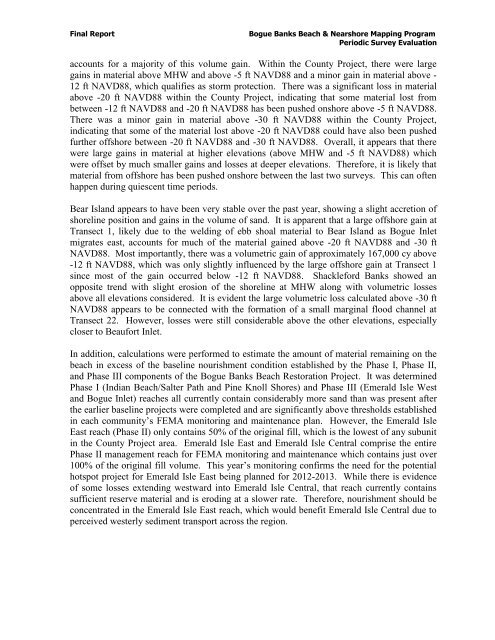Bogue Banks Beach - Carteret County Shore Protection Office
Bogue Banks Beach - Carteret County Shore Protection Office
Bogue Banks Beach - Carteret County Shore Protection Office
Create successful ePaper yourself
Turn your PDF publications into a flip-book with our unique Google optimized e-Paper software.
Final Report <strong>Bogue</strong> <strong>Banks</strong> <strong>Beach</strong> & Nearshore Mapping Program<br />
Periodic Survey Evaluation<br />
accounts for a majority of this volume gain. Within the <strong>County</strong> Project, there were large<br />
gains in material above MHW and above -5 ft NAVD88 and a minor gain in material above -<br />
12 ft NAVD88, which qualifies as storm protection. There was a significant loss in material<br />
above -20 ft NAVD88 within the <strong>County</strong> Project, indicating that some material lost from<br />
between -12 ft NAVD88 and -20 ft NAVD88 has been pushed onshore above -5 ft NAVD88.<br />
There was a minor gain in material above -30 ft NAVD88 within the <strong>County</strong> Project,<br />
indicating that some of the material lost above -20 ft NAVD88 could have also been pushed<br />
further offshore between -20 ft NAVD88 and -30 ft NAVD88. Overall, it appears that there<br />
were large gains in material at higher elevations (above MHW and -5 ft NAVD88) which<br />
were offset by much smaller gains and losses at deeper elevations. Therefore, it is likely that<br />
material from offshore has been pushed onshore between the last two surveys. This can often<br />
happen during quiescent time periods.<br />
Bear Island appears to have been very stable over the past year, showing a slight accretion of<br />
shoreline position and gains in the volume of sand. It is apparent that a large offshore gain at<br />
Transect 1, likely due to the welding of ebb shoal material to Bear Island as <strong>Bogue</strong> Inlet<br />
migrates east, accounts for much of the material gained above -20 ft NAVD88 and -30 ft<br />
NAVD88. Most importantly, there was a volumetric gain of approximately 167,000 cy above<br />
-12 ft NAVD88, which was only slightly influenced by the large offshore gain at Transect 1<br />
since most of the gain occurred below -12 ft NAVD88. Shackleford <strong>Banks</strong> showed an<br />
opposite trend with slight erosion of the shoreline at MHW along with volumetric losses<br />
above all elevations considered. It is evident the large volumetric loss calculated above -30 ft<br />
NAVD88 appears to be connected with the formation of a small marginal flood channel at<br />
Transect 22. However, losses were still considerable above the other elevations, especially<br />
closer to Beaufort Inlet.<br />
In addition, calculations were performed to estimate the amount of material remaining on the<br />
beach in excess of the baseline nourishment condition established by the Phase I, Phase II,<br />
and Phase III components of the <strong>Bogue</strong> <strong>Banks</strong> <strong>Beach</strong> Restoration Project. It was determined<br />
Phase I (Indian <strong>Beach</strong>/Salter Path and Pine Knoll <strong>Shore</strong>s) and Phase III (Emerald Isle West<br />
and <strong>Bogue</strong> Inlet) reaches all currently contain considerably more sand than was present after<br />
the earlier baseline projects were completed and are significantly above thresholds established<br />
in each community’s FEMA monitoring and maintenance plan. However, the Emerald Isle<br />
East reach (Phase II) only contains 50% of the original fill, which is the lowest of any subunit<br />
in the <strong>County</strong> Project area. Emerald Isle East and Emerald Isle Central comprise the entire<br />
Phase II management reach for FEMA monitoring and maintenance which contains just over<br />
100% of the original fill volume. This year’s monitoring confirms the need for the potential<br />
hotspot project for Emerald Isle East being planned for 2012-2013. While there is evidence<br />
of some losses extending westward into Emerald Isle Central, that reach currently contains<br />
sufficient reserve material and is eroding at a slower rate. Therefore, nourishment should be<br />
concentrated in the Emerald Isle East reach, which would benefit Emerald Isle Central due to<br />
perceived westerly sediment transport across the region.


